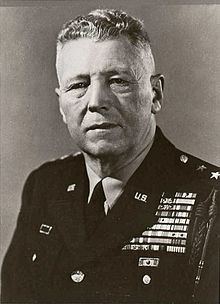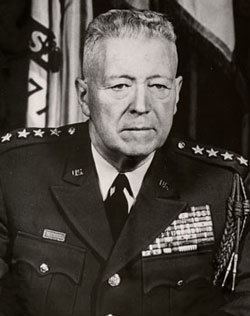Allegiance United States Name Bruce Clarke | ||
 | ||
Born April 29, 1901Adams, New York ( 1901-04-29 ) Commands held Continental Army CommandU.S. Army EuropeU.S. Army, PacificI CorpsX CorpsFirst Republic of Korea Army1st Armored Division Battles/wars World War IWorld War IIKorean War Died March 17, 1988, Washington, D.C., United States Place of burial Arlington National Cemetery, Arlington, Virginia, United States Similar People Hasso von Manteuffel, Walter Model, Bernard Montgomery - 1st Visco, Arthur W Radford | ||
Years of service 1917–19211925–1962 | ||
Bruce Cooper Clarke was a United States Army general. He was a career officer who served in World War I, World War II, and the Korean War. He was the commander of Continental Army Command from 1958–1960, Commander, U.S. Army Europe from 1960-1962, and commanded the U.S. Army, Pacific from December 1954 to April 1956.
Contents

Biography
Clarke was born on a farm in Adams, New York, on April 29, 1901. He dropped out of high school to enlist in the Army in 1917, and gained appointment to the United States Military Academy through the New York National Guard. He graduated in 1925 with a commission in the Corps of Engineers. In addition to his degree from West Point, he earned a civil engineering degree from Cornell University and an LL.B. from La Salle Extension University. He also was an equivalent graduate of the National War College and is credited with starting the Non-Commissioned Officers Academy system. From 1958 to 1960 he commanded the Continental Army Command, heading the entire Army school system which, at the time, had over 250,000 participants.
During World War I, Clarke served in the Coast Artillery Corps. In the Second World War, as a colonel and then a brigadier general, he commanded Combat Command A (CCA) of the U.S. 4th Armored Division in Gen. George S. Patton's Third Army, leading it to victory over a superior German armored force at the Battle of Arracourt in September 1944. In December Clarke led the relief of St. Vith during the Battle of the Bulge, which slowed the German attack. Writing afterward, General Eisenhower credited Clarke's actions as the "turning point" in that battle.
During the Korean War, General Clarke commanded the I Corps and the X Corps. He also trained the First Republic of Korea Army.
Peacetime major commands for General Clarke include Commanding General of the 1st Armored Division, Fort Hood, Texas, from 1951 to 1953. After his tour in Hawaii, he commanded the Seventh United States Army in Germany. He received a promotion to the rank of four-star general in August 1958. From 1960–1962 he served as Commander in Chief of US Army, Europe, before retiring on April 30, 1962.
He and his wife, Bessie, had three sons and one daughter.
On October 18, 1971 The Supreme Council of the Scottish Rite for the Southern Jurisdiction of the United States conferred upon Clarke, 33 degree, U.S. Army Ret., the Grand Cross of the Court of Honor.
This is the highest Masonic award, with only 11 holders out of 600,000 members in the Scottish Rite in that Jurisdiction.
Military decorations
Clarke's U.S. military decorations include the Distinguished Service Cross, three Army Distinguished Service Medals, three Silver Stars, the Legion of Merit, and three Bronze Stars. He also received decorations from foreign countries including France, Germany, Great Britain, Korea, and the Philippines.
Death and burial
Clarke died on March 17, 1988 and was buried with full military honors in Section 7-A (Grave 130) at Arlington National Cemetery. His wife, Bessie Mitchell Clarke, is buried with him.
